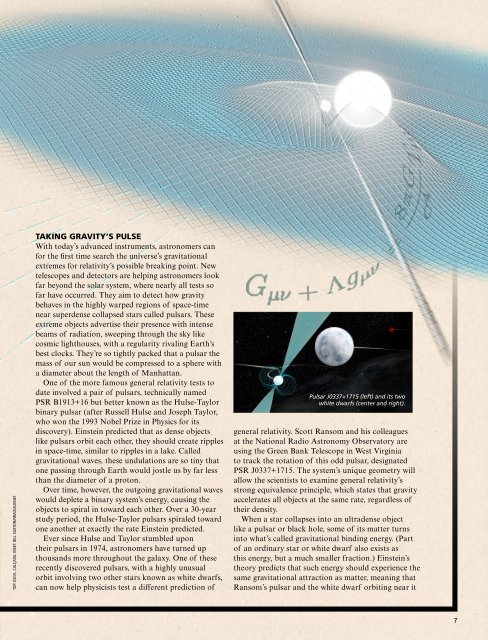GRAVITATIONAL WAVES
DIG-ASY-PRM_GravWavesFIN
DIG-ASY-PRM_GravWavesFIN
You also want an ePaper? Increase the reach of your titles
YUMPU automatically turns print PDFs into web optimized ePapers that Google loves.
TOP: ESO/L. CALÇADA. INSET: BILL SAXTON/NRAO/AUI/NSF<br />
TAKING GRAVITY’S PULSE<br />
With today’s advanced instruments, astronomers can<br />
for the first time search the universe’s gravitational<br />
extremes for relativity’s possible breaking point. New<br />
telescopes and detectors are helping astronomers look<br />
far beyond the solar system, where nearly all tests so<br />
far have occurred. They aim to detect how gravity<br />
behaves in the highly warped regions of space-time<br />
near superdense collapsed stars called pulsars. These<br />
extreme objects advertise their presence with intense<br />
beams of radiation, sweeping through the sky like<br />
cosmic lighthouses, with a regularity rivaling Earth’s<br />
best clocks. They’re so tightly packed that a pulsar the<br />
mass of our sun would be compressed to a sphere with<br />
a diameter about the length of Manhattan.<br />
One of the more famous general relativity tests to<br />
date involved a pair of pulsars, technically named<br />
PSR B1913+16 but better known as the Hulse-Taylor<br />
binary pulsar (after Russell Hulse and Joseph Taylor,<br />
who won the 1993 Nobel Prize in Physics for its<br />
discovery). Einstein predicted that as dense objects<br />
like pulsars orbit each other, they should create ripples<br />
in space-time, similar to ripples in a lake. Called<br />
gravitational waves, these undulations are so tiny that<br />
one passing through Earth would jostle us by far less<br />
than the diameter of a proton.<br />
Over time, however, the outgoing gravitational waves<br />
would deplete a binary system’s energy, causing the<br />
objects to spiral in toward each other. Over a 30-year<br />
study period, the Hulse-Taylor pulsars spiraled toward<br />
one another at exactly the rate Einstein predicted.<br />
Ever since Hulse and Taylor stumbled upon<br />
their pulsars in 1974, astronomers have turned up<br />
thousands more throughout the galaxy. One of these<br />
recently discovered pulsars, with a highly unusual<br />
orbit involving two other stars known as white dwarfs,<br />
can now help physicists test a different prediction of<br />
Pulsar J0337+1715 (left) and its two<br />
white dwarfs (center and right).<br />
general relativity. Scott Ransom and his colleagues<br />
at the National Radio Astronomy Observatory are<br />
using the Green Bank Telescope in West Virginia<br />
to track the rotation of this odd pulsar, designated<br />
PSR J0337+1715. The system’s unique geometry will<br />
allow the scientists to examine general relativity’s<br />
strong equivalence principle, which states that gravity<br />
accelerates all objects at the same rate, regardless of<br />
their density.<br />
When a star collapses into an ultradense object<br />
like a pulsar or black hole, some of its matter turns<br />
into what’s called gravitational binding energy. (Part<br />
of an ordinary star or white dwarf also exists as<br />
this energy, but a much smaller fraction.) Einstein’s<br />
theory predicts that such energy should experience the<br />
same gravitational attraction as matter, meaning that<br />
Ransom’s pulsar and the white dwarf orbiting near it<br />
7


